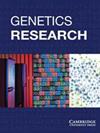TPX2作为癌症易感基因与癌症预后不良密切相关
IF 2.1
4区 生物学
Q4 GENETICS & HEREDITY
引用次数: 1
摘要
背景癌症(EC)是一种常见的生殖道肿瘤,影响女性生殖系统,但治疗方案有限。我们旨在发现新的EC预后生物标志物。方法我们使用信使核糖核酸序列数据来检测EC和对照组织之间的差异表达基因(DEGs)。收集了详细的临床病理信息,分析了EC中hub DEG的mRNA和蛋白质水平的变化。还评估了拷贝数变异(CNV)与EC发病机制的关系。进行了基因集富集分析(GSEA),以丰富hub基因驱动的重要途径。Cox回归分析用于选择变量以创建列线图。通过应用一致性指数(C指数)校准列线图,并使用决策曲线分析(DCA)量化列线图在不同阈值概率下的净收益。结果差异表达分析发现24个DEG是EC的潜在危险因素。生存分析显示,TPX2的表达与晚期EC患者的总生存率恶化有关。高CNV与TPX2的过表达有关;这表明细胞周期途径的改变可能对EC的发展至关重要。此外,结合临床因素,为TPX2开发了个性化列线图;还对其预测EC的能力进行了评估。校准和DCA分析证实了列线图的稳健性和临床实用性。结论我们对EC的发病机制和分子机制提供了新的见解。TPX2的过度表达与预后较差有关,可作为预测EC患者预后的生物标志物。本文章由计算机程序翻译,如有差异,请以英文原文为准。
TPX2 Serves as a Cancer Susceptibility Gene and Is Closely Associated with the Poor Prognosis of Endometrial Cancer
Background Endometrial cancer (EC) is a common tumor of the genital tract that affects the female reproductive system but with only limited treatment options. We aimed to discover new prognostic biomarkers for EC. Methods We used mRNA-seq data to detect differentially expressed genes (DEGs) between EC and control tissues. Detailed clinicopathological information was collected, and changes in the mRNA and protein levels of hub DEGs were analyzed in EC. Copy number variation (CNV) was also evaluated for its association with the pathogenesis of EC. Gene set enrichment analysis (GSEA) was conducted to enrich significant pathways driven by the hub genes. Cox regression analysis was used to select variables to create a nomogram. The nomogram was calibrated by applying the concordance index (C-index), and net benefits of the nomogram at different threshold probabilities were quantified using decision curve analysis (DCA). Results Differential expression analysis identified 24 DEGs as potential risk factors for EC. Survival analysis revealed that TPX2 expression was related to worsening overall survival in patients with advanced EC. A high CNV was associated with the overexpression of TPX2; this suggested that modifications in the cell-cycle pathway might be crucial in the advancement of EC. Moreover, an individualized nomogram was developed for TPX2 incorporating clinical factors; this was also evaluated for its ability to predict EC. Calibration and DCA analyses confirmed the robustness and clinical usefulness of the nomogram. Conclusion We offer novel insights into the pathogenesis and molecular mechanisms of EC. The overexpression of TPX2 was related to a poorer prognosis and could serve as a biomarker for predicting prognostic outcomes in EC patients.
求助全文
通过发布文献求助,成功后即可免费获取论文全文。
去求助
来源期刊

Genetics research
生物-遗传学
自引率
6.70%
发文量
74
审稿时长
>12 weeks
期刊介绍:
Genetics Research is a key forum for original research on all aspects of human and animal genetics, reporting key findings on genomes, genes, mutations and molecular interactions, extending out to developmental, evolutionary, and population genetics as well as ethical, legal and social aspects. Our aim is to lead to a better understanding of genetic processes in health and disease. The journal focuses on the use of new technologies, such as next generation sequencing together with bioinformatics analysis, to produce increasingly detailed views of how genes function in tissues and how these genes perform, individually or collectively, in normal development and disease aetiology. The journal publishes original work, review articles, short papers, computational studies, and novel methods and techniques in research covering humans and well-established genetic organisms. Key subject areas include medical genetics, genomics, human evolutionary and population genetics, bioinformatics, genetics of complex traits, molecular and developmental genetics, Evo-Devo, quantitative and statistical genetics, behavioural genetics and environmental genetics. The breadth and quality of research make the journal an invaluable resource for medical geneticists, molecular biologists, bioinformaticians and researchers involved in genetic basis of diseases, evolutionary and developmental studies.
 求助内容:
求助内容: 应助结果提醒方式:
应助结果提醒方式:


